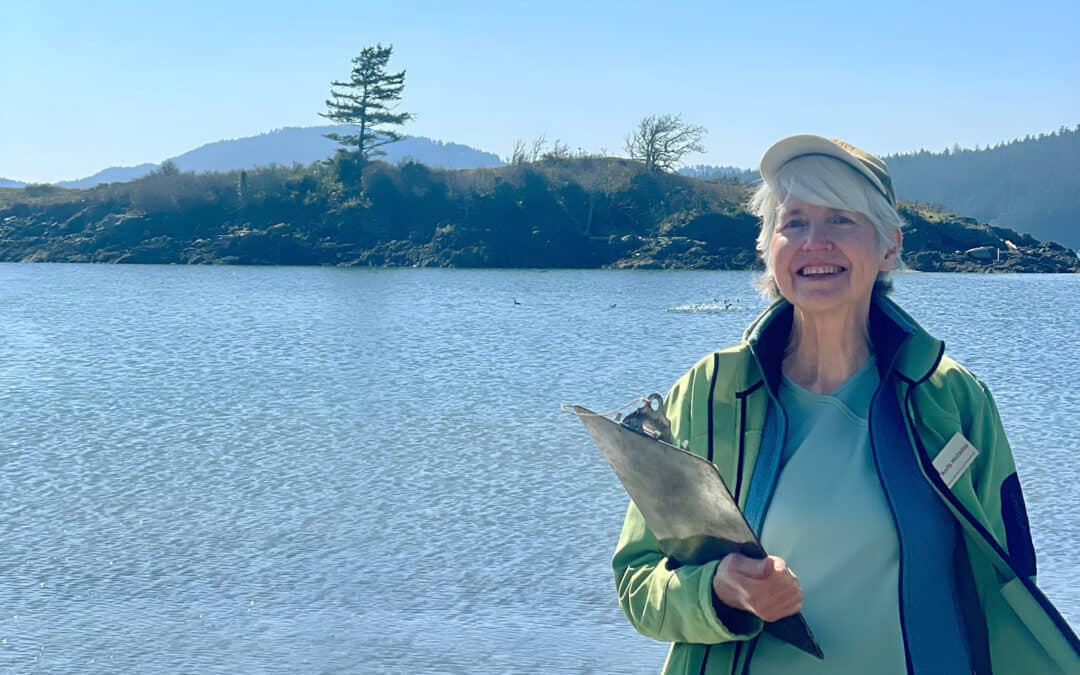Anita Holliday
Kwiáht, Volunteer
Can you share a little bit about yourself?
I moved from Seattle to Orcas 31 years ago with my then-husband and our infant daughter, having lived in a few other states until my early thirties. I have had the good fortune to have an OPAL home for the past 23 years. I’ve been a massage therapist since my late 20s, mostly at the Healing Arts Center since being here, but I’m easing into a much smaller practice, mostly with elders in their homes. I’ve shown my photographs at the local banks and the Orcas Center since 2005 and write poetry — sharing but not yet publishing my work. Ask me about my toddler grandson you may be shown photos and get an earful! I design flower arrangements for the Orcas Island Chamber Music Festival and help with their concerts and other events at the Orcas Center throughout the year, all as a volunteer.
Tell us a little bit about the organization you volunteer at?
The group that I’ve spent the most hours with is Kwiáht — a nonprofit scientific organization based on Lopez Island that works throughout the San Juans to protect, study, and educate the public about many aspects of our islands. Russel Barsh is the Founder and Director of the organization. Kwiáht’s projects have touched on everything from birds and bats to plankton surveys and toxic algae, newts and insects, heritage fruit trees to a revival of knowledge about camas bulbs — a staple food in the diets of the indigenous islanders before settler times. Botanist Madrona Murphy takes the lead on the plant-related projects. There has been a lot of outreach to kids and youth of all ages in island schools.
My focus since 2008 is what we call the Indian Island Marine Health Observatory. We diligently study, with the help of citizen volunteers and youth interns, the tiny island just offshore from downtown Eastsound, which is accessible by foot from April through August during the low tides twice a month. We track the bird life and encourage visitors to leave the island top undisturbed during the nesting weeks of the black oystercatcher, a seabird that nests right on the ground. Twice each month we do a no-kill fish seine to study the several species of interesting fish that breed near the island. We regularly survey the sea stars, the clams, the crabs, and the eelgrass meadows. Our data is reported annually to interested community members, as well as to larger scientific or governmental organizations who sometimes wish to look at our data.
What does volunteering do for you?
I don’t have a background in science, but it’s been so much fun learning to grab a squirming, slippery fish from a bucket without hurting it, measure it, and get it back to the water. To identify crabs by species, even when very tiny, using appearance and behavior as clues. I get a real thrill seeing rare species, by virtue of being out there so regularly. I feel helping keep a detailed record matters — recording baseline populations and fluctuations. Living very close to the little island, I also feel responsible for helping to protect Indian Island’s defenseless creatures by educating the mostly well-meaning visitors (more every year) to better understand the unique and fragile environment they’re setting foot on. I want to impress on Orcas folks how satisfying it is to volunteer with Kwiáht and encourage them to join in!
Visit Kwiáht to learn more. Reach out to them if you would like to get involved.
If you would like to learn about other volunteer opportunities on Orcas, please email Ed. He would love to get together for tea/coffee to chat about your interests.

